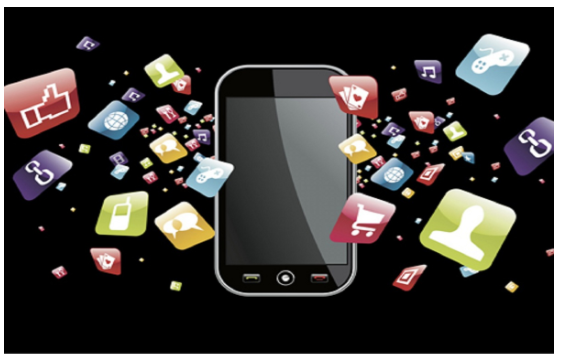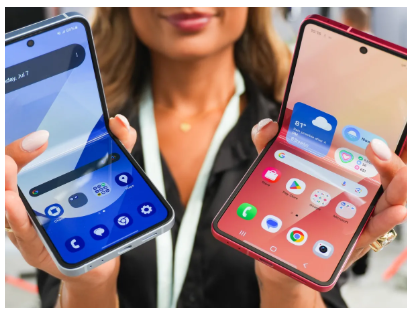US and international youth are staging a quiet revolution: not so much in opposition to the technology per se, but in opposition to the economy and the sentiments that result from a day spent staring at screens. Mainstream media is taking notice: extensive coverage in The Wall Street Journal and cover stories about the increasing popularity of quiet phones and meditative disconnection have all been recently highlighted.
The slang for the trends changes: “digital minimalism,” “appstinence,” “flip-phone summers,” but on the horizon is a new one: the New Luddites. Not 19th-century machine-breakers, however, but “former screenagers” in quantity, who are reportedly bringing back hardware and activities immune to distraction and attention-as-commodity. The campaign employs collective action on a mass level (rebooting a phone) with public mobilization: phone-free peer-to-peer events and phone-free public spaces are being sponsored by campus clubs and youth groups. There are clubs in some schools and communities. See coverage of one such group at CBS News.

Gen Z is quietly pushing back against screen-driven culture, and major media are taking notice. (Image Source: Medium)
Why now? The reasons add up nicely. Testimony to the harms inflicted by bottomless feeds: pain, divided attention, and now more than ever, the feeling that social media itself is not real, all give the movement cultural oxygen. And in being consumed, the feed itself evolves: a flood of cheaply produced machine-generated content and highly produced influencer content leaves many feeling like they don’t recognize the site. Red flags appear about reaching “Posting Zero,” that moment when regular people just post nothing at all anymore, since posts are filled with paid ads, professionally crafted influencer posts, and bottom-of-the-barrel mass-produced trash. See Kyle Chayka’s piece on posting fatigue in The New Yorker.
Social pressure is literally in phones. There is more demand and selling of “dumbphones” and low-end phones: not so much because phone manufacturers in high-street are falling into that space, but because there is economically viable demand for small, single-purpose phones. They carry brands such as Light and Punkt, and specialty designers like Unihertz with diminutive models like the Jelly Star, which take orders for phones that are “too small to get addicted to” or are built to eliminate attention-grabbing hooks. For background on minimalist devices, see Unihertz Jelly Star information and Light Phone details.
What’s It Like On The Ground
The flip can be dramatic. YouTube and TikTok are replete with “I went dumbphone for a month” vlogs: short diaries in which creators chronicle the disorientation, regained time, and the occasional practical snag (maps, banking apps, or ride-hailing). Organizers stage “phone surrender” dinners and study groups in schools and at community meetings where phones are left outside. The aim is not moralizing: it is reclaiming attention. Students talk about being less reactive, more present, and less metric-driven. See example videos on YouTube.
For others, aesthetic conversion occurs. Vinyl records, film cameras, and vintage gear make up a counter-cultural uniform: in defiance of hyper-convenience for more laid-back practices that feel deliberately human. That visual crossover makes the movement contagious: it is shareable, aspirational, and marketable; an irony, because anything marketable risks becoming just one more thing attention-wise. For coverage of the cultural crossover, see reporting in The Guardian.
The Market Strikes Back
Markets follow social norms. When social norms shift, markets shift. Small firms and some larger firms are selling more high-end or strategic dumbphones: button phones, long battery life, and small applications. Some firms position the product as a wellness purchase; others frame it as an anti-attention or privacy product. Business stories and news accounts confirm actual revenue growth for specialty brands, with revenues for some of the smaller players doubling over recent years. The result: users who do not want to disappear but who want fewer hooks have choices.
Large producers and platforms, however, report behavioral fissures. The problem of “posting fatigue” risks losing the actual bread-and-butter human content that makes feeds feel organic. Product teams are experimenting with policies and product levers, and creators are attempting to adjust: more narrative, deeper community integration, and more premium paid content. A widespread easing of daily posting would steer digital marketing activity into territories crypto teams and other marketers cannot ignore.

Dumbphone sales rise as markets adapt, while platforms battle “posting fatigue.” (Image Source: Indian Retailer)
A Parenthesis On The AI Element (Why It Matters)
Two problems that are connected drive individuals away from screens. First, the sheer amount of machine-generated or machine-assisted content makes the feed noisier and less selective. Second, attention economies are set up to reward super-optimized, fast production that prioritizes engagement over depth. After ordinary posts are overwhelmed, the platform no longer feels like it is for most people. That is the cultural context where the New Luddites resonate: not anti-technology but anti-exploitation by systems set up to win attention. Kyle Chayka captures the risk of casual posting fading in his New Yorker essay.
Why It’s Significant Across The Board: Including Crypto Individuals
If you are a crypto investor, think of distribution and attention as pipes. Meme pipes, news pipes, and token launch pipes all depend on regular people reading and re-sharing. A shift to phone-free lives, or a balkanization of free-wheeling sharing, alters the nature of organic discovery:
- Organic Reach Is Affected: fewer posts equals fewer organic viral sparks, so discovery becomes more expensive.
- Signal-To-Noise Drifts: when spammy marketing pushes or highly produced content overwhelm feeds, genuine community signals become drowned out.
- Community Strategies Gain Prominence: real-world meetups, small active groups, and on-chain community rewards can become more effective than strategies that rely solely on social virality.
That is not a catastrophe; it is a plan adjustment. Communities that anchor people in value, place, and real usefulness can thrive even when attention markets re-price. This is analysis and strategy, not a wager on particular projects or price movements.

Gen Z’s screen rebellion is changing how trends spread. (Image Source: CryptoRobotics)
Real Borders And Social Pressure
There is a disadvantage to the revolution. Not everyone can go off-grid: many services assume smartphone connectivity. Teenagers who rely on online communities for support or work could be disadvantaged by an outright switch. Schools and institutions must weigh phone policy against equity and safety considerations. And there is a fear that digital minimalism becomes a consumer aesthetic out of reach for many: dumbphones can be a new status symbol in some places. Reporting on the trend uncovers these paradoxes.
Voices And Initial Results
Students: College clubs and phone-free social events indicate greater concentration and more interpersonal communication. Several multichapter clubs provide peer support for phone conversions. See coverage of organized student groups at CBS News.
Parents: Many welcome the change for younger teens, reporting better sleep and less daily drama. Parents also discuss safety and practical concerns; see related reporting.
Creatives And Journalists: Some lament a loss if posting volume dwindles, while others welcome the chance to compete on quality rather than algorithmic legerdemain.
Marathon, Handy Tip (For Intrepid Readers To Try)
Phone-free evening: leave your phone charging in another room one weeknight. If you require a backup phone, use a barebones feature phone or a stripped-down model; these reduce friction but keep calls possible. For data on the cultural buzz and device choices, see the analysis from Meltwater.
What To Learn From Actual Groups And Campuses
Find the teen groups at the forefront of this movement. School clubs work in small study groups of students collaborating to minimize phone time and maximize person-to-person contact. They meet, run phone-free gatherings, and share tips on trading smartphones for dumbphones. These chapters began small and are now growing. Coverage of local chapters exists in mainstream reporting.

Teen groups are leading the movement with phone-free clubs and growing local chapters. (Image Source: Edutopia)
The local chapters matter: they prove the movement is not some transient online trend. It spreads by contact between real human beings: friend to friend, encouraging behavior change. That social glue makes habits stick.
Case Study: Operation Of A Campus Chapter
Typical weekly routines include leaving phones outside for an hour, reading, playing board games, or walking. No lecture, no moralizing; just practical help. Leaders offer gentle nudges: “one phone-free meal a day” or “one week with boundaries.” Members report better sleep, fewer notification-driven conflicts, and more real friendships. Small wins add up.
Device Landscape: What Consumers Actually Buy
People purchase different devices for different goals. Some buy a feature phone or flip phone for calls and texts only. Others buy very small smartphones with tiny screens to discourage frequent use.
Brands and launches are market responses. Expect flip-phone re-releases, low-profile minimalist manufacturers, and compact phones that stop people from losing themselves in endless scrolling. Short videos and user reviews often say a smaller screen discourages casual scrolling, making the phone a behavioral tool rather than a mere object.

Consumers choose flip and mini phones to curb scrolling and regain focus. (Image Source: ZDNET)
Brand Differentiation: Snap Brief
- Punkt and Light produce slow, well-made phones with long battery life.
- Unihertz produces very small phones that limit engagement by design.
- Big players test hybrid, low-feature models, signaling market broadening.
You do not need a headline model to succeed. The point is that the device should match the person’s goal: focus, privacy, or less anxiety.
Practical Tip: Trial The Switch Without Disrupting Life
You can test the idea without buying a new phone:
- Try a “phone-free evening” or one phone-free day per week.
- Limit apps: uninstall social apps or log out. Turn off notifications.
- Use built-in digital wellbeing controls to block distracting apps for set hours.
- If you need essential apps (banking, maps), keep them, but create friction: remove social accounts from the phone or place social apps in a hard-to-reach folder.
These steps help reclaim time without sacrificing work, money, or safety.
What Parents And Teachers Must Balance
Schools want to focus, but must prioritize safety and equity. Blanket bans are simple but unfair to students who need phones for transit, family contact, or classroom resources. A better approach is nuance: voluntary phone-free zones, taught focus skills, and support for students who cannot easily disconnect. Parents can coordinate practical plans: emergency contact methods, rideshare arrangements, and homework options that need web access.

Schools and parents balance focus and safety with smartphone-free strategies. (Image Source: The International School of Thrissur)
What This Does To Small Businesses And Communities
Face-to-face groups and local meetups gain value when phones lose prominence. Bookshops, cafés, and event organizers can offer “phone-free hours” that attract people seeking quieter, more authentic social spaces. The movement can spur local economies: events, analog hobbies, and products that support a slower life.
Consequences For Crypto Teams And Marketers
If daily posting drops, organic reach falls. That changes discovery costs and velocity. For crypto projects, rethink outreach:
- Build in-person meetups and local chapters.
- Use email and push channels, not just social platforms.
- Reward small, active communities with real utility: token drops, early access or local events.
- Prioritize long-term retention over short viral bursts.
These strategies require more effort but produce closer, more resilient communities.
Three Possible Futures: What’s Next
- Rebalance: Platforms nudge toward quality. People post less often, but content feels real again; organic discovery becomes rarer and more valuable.
- Posting Zero: Ordinary people stop posting. Feeds fill with polished marketing and automated posts, raising costs and eroding trust. See the New Yorker discussion of “Posting Zero.”
- Hybrid: Platforms and users adapt. Niche platforms and small communities grow. Social life blends analog and digital habits.
Each future asks new practices from builders, makers, and marketers.
Privacy, Platform Responsibility, and Design
Design choices matter. Platforms can reduce harm by slowing reward loops that make scrolling compulsive. That can include fewer random recommendations, stronger privacy defaults, and clearer labeling of algorithmic or machine-assisted content. Policymakers and schools can promote humane defaults without outright bans.

Smarter design and privacy defaults help platforms reduce harm. (Image Source: Usercentrics)
Tools And Resources: Brief List
- Consider a low-distraction handheld phone if you want a hardware change.
- Use built-in digital-wellbeing tools on most phones.
- Find an “offline buddy” who calls you daily.
- For groups: create a light code of conduct for phone-free meetups and a clear safety policy.
- For market data and trends, see Meltwater.
Also Read: The AI Kingmaker War: AMD’s $26 Billion Bet to Topple Nvidia’s Trillion-Dollar Throne
FAQ: Short Answers
Q: Would work be impacted by going dumbphone?
A: Possibly if your role needs instant apps. Test small changes first. Keep a backup phone or keep key apps, but limit others.
Q: Are dumbphones cheaper or more expensive?
A: Very cheap basic phones exist. Designer minimalist phones cost more. Choose based on budget and goals. See reporting and market analysis.
Q: Is it just a rich fad?
A: Some elements are aesthetic and pricier, but many practical steps, removing apps, scheduling phone-free time, cost nothing.
Q: What if platforms get overwhelmed with machine-made posts?
A: That forces stronger community work. Projects that build local bonds and create genuine value will be more resilient. The “Posting Zero” concept outlines this risk.
Q: What Are The New Luddites?
A: A loosely structured group of mainly young people who deliberately reduce exposure to attention-harvesting feeds and apps, favoring feature phones or phone-abstinence practices to regain time and attention. See coverage of real campus groups.
Q: Are dumbphones actually selling more?
A: Niche interest and demand are rising: specialist companies report increased sales and retailers note higher searches and purchases for retro and feature phones. The market remains small compared with smartphones, but growth is evident.
Q: Anti-technology?
A: No. Most participants draw a line between tools and the way platforms commoditize attention. They adopt technology on their terms, with fewer hooks.
Q: Will this affect crypto projects?
A: Possibly. Crypto marketing that relies on organic social virality may find discovery more costly. Projects grounded in community utility, face-to-face meetups, and long-term commitment will be better placed.
Conclusion
The New Luddite movement is less a revolt against technology and more a protest against its terms. By choosing simpler tools and clearer boundaries, youth push back against attention-driven platform design. The movement reveals fatigue with constant stimulation and a wish for more deliberate connection. For people, it offers ways to regain focus. For business and society, it forces a rethink about how we design, market, and live with technology. Regardless of the future path, this wave has begun an overdue conversation about control, design, and how we want technology to shape our lives.

